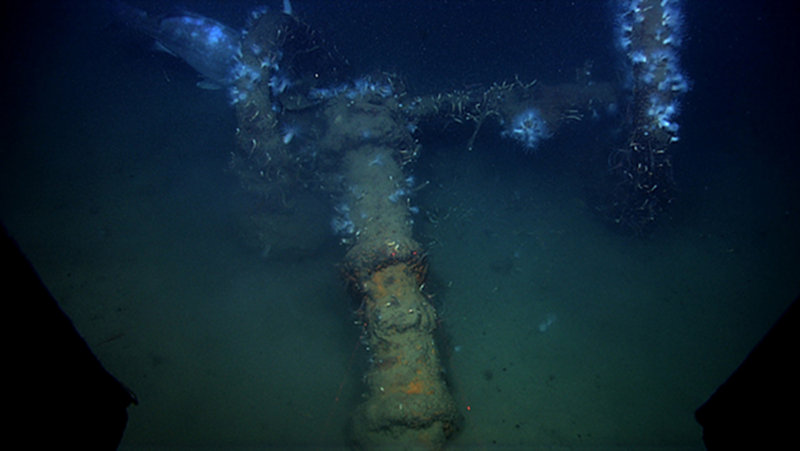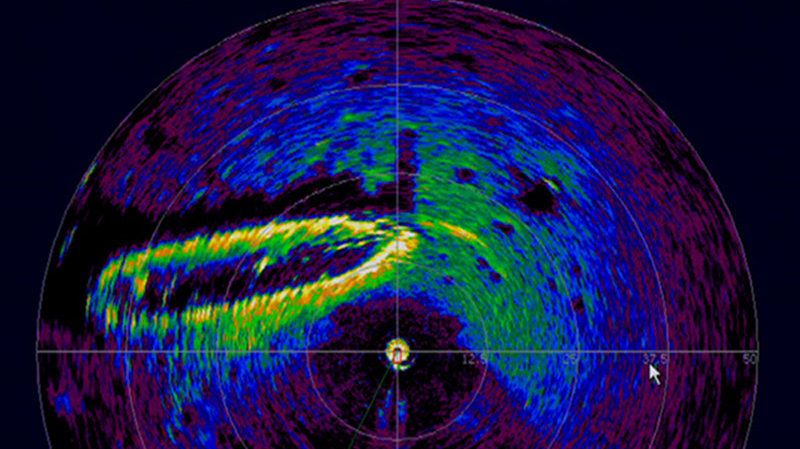
By Karl McLetchie, ROV Team - SeaKnowledge
March 30, 2012

Ship timbers covered in anemone rising from the sediment. Four copper alloy fasteners sticking out the wood secured a wooden hull plank that has been consumed by marine organisms. Image courtesy of the NOAA Office of Ocean Exploration and Research, Gulf of Mexico Expedition 2012. Image courtesy of the NOAA Office of Ocean Exploration and Research, Gulf of Mexico Expedition 2012. Download larger version (jpg, 1.2 MB).
During the Fall of 2009, sometime after I escaped from my engineering cubicle to become an ocean explorer, but before I became a remotely operated vehicle (ROV) pilot on the Okeanos Explorer, I had the pleasure of participating in a shipwreck survey in the Gulf of Mexico. I worked with the University of Mississippi’s Undersea Vehicles Technology Center, helping them to image potential shipwreck targets with their two autonomous underwater vehicles (AUVs).
Video footage captured by the Little Hercules ROV and camera platform during the March 30 ROV dive from NOAA Ship Okeanos Explorer during the Gulf of Mexico Expedition 2012. Video courtesy of the NOAA Office of Ocean Exploration and Research, Gulf of Mexico Expedition 2012. Download (mp4, 178.7 MB).
One AUV was designed to make high-resolution multibeam bathymetry maps of the seafloor and the other AUV was designed to take digital photographs of the seafloor. The goal was to gather enough information on the targets to determine if they were shipwrecks and if they were worth further investigation. The most interesting wreck to me was VK0986; 50 meters long, 15 meters wide, wooden timbers, a “cannon-like” object … the ship had to have a sordid past and be full of gold doubloons. Only further investigation would tell.
Today’s dive, Dive 10, was on wreck VK0986. It is close to the mouth of the Mississippi River and we experienced strong currents and murky water; conditions that we don’t find during our work farther out to sea. Our usual method of navigating Little Hercules visually using Seirios’ overhead view would not work as all we could see from Seirios was a vague, brown glow. Using Little Hercule’s imaging sonar and our acoustic tracking system, we were able to locate the wreck and safely position Little Hercules close enough to start the video survey. We circled the wreck slowly, being careful not to disturb the anemone-covered timbers rising out of the sediment or the sediment itself.

This 19th century bilge pump kept water out of the hull. It was found some distance away from the hull. Image courtesy of the NOAA Office of Ocean Exploration and Research, Gulf of Mexico Expedition 2012. Download larger version (jpg, 1.3 MB).

Little Hercules scanning sonar images the entire wreck. Image courtesy of the NOAA Office of Ocean Exploration and Research, Gulf of Mexico Expedition 2012. Download larger version (jpg, 644 KB).
Once the perimeter survey was complete, the current subsided and maneuverability and visibility improved significantly. Little Hercules was able to fly over and at times down into the wreck to collect detailed imagery. We imaged some interesting wood and iron artifacts, but saw no sign of the “cannon-like” object. Looking back over the AUV images and navigation data we realized that the object actually lay 10 meters outside of the wreck. Close inspection of the object by Little Hercules revealed to the archeologists that it was likely a bilge pump, not a cannon.
No gold doubloons, no cannon, but a challenging and fascinating dive. I hope to return to VK0986 to do more research to find clues that may help identify the ship.